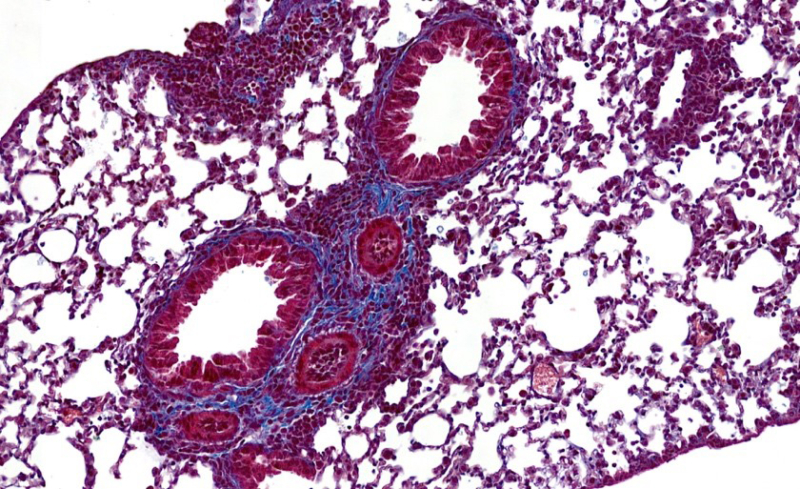Follow us on Google News (click on ☆)

Cross-section of a mouse lung subjected to a respiratory inflammation protocol showing immune cell infiltration and collagen deposits characteristic of extracellular matrix remodeling in the lung.
© Kilian Maire, Pierre Lutz & Isabelle Lamsoul
The identification of new therapeutic targets therefore remains a challenge. In an article published in Nature Communications, scientists demonstrate, in mice, that it is possible to specifically target Th2 lymphocytes, the main culprits of type 2 inflammation.
Type 2 lymphocytes, key players in type 2 inflammation
Type 2 inflammation is naturally induced in cases of parasitic infection or dangerous environmental exposure. When elevated, it can have a significant impact on quality of life. It is found in the majority of asthmatic patients.
When sentinel cells of our immune system spring into action in the presence of an allergen, they trigger a series of biological reactions that, in the case of type 2 inflammation, amplify a category of cells called Th2 lymphocytes. These represent a major source of type 2 cytokines that play an active role in the development of these pathologies.
This is why most current therapeutic antibodies target type 2 cytokines and their receptors. Another therapeutic approach would be to inhibit the recruitment of Th2 lymphocytes to the inflammatory site.
The ubiquitination enzyme ASB2a, a potential target of Th2 lymphocytes
The scientists in the study published in Nature Communications are studying ubiquitination enzymes, which are responsible for adding ubiquitin molecules to their targets in order to regulate their biological function or fate. These enzymes therefore represent a new family of pharmacological targets in various pathologies related to the immune system.
They have just highlighted that one of these enzymes, ASB2a, promotes the degradation of filamins A and B, proteins that organize the cell cytoskeleton and regulate their motility, in Th2 lymphocytes. Low levels of filamins A and B confer on these cells a specific elongated morphology, giving them optimal migratory properties.
Using different models of respiratory inflammation in mice, the scientists observed that reducing the expression of ASB2a in Th2 lymphocytes was accompanied by a reduction in their recruitment to inflamed lungs and, consequently, an attenuation of respiratory inflammation, mucus production, and bronchial hyperreactivity.
This work sheds light on a new pathway controlling the functions of Th2 lymphocytes responsible for the deleterious immune response in the lungs of patients with type 2 asthma. They suggest that inhibiting ASB2α and/or increasing the amounts of filamins A and B appears as a new therapeutic opportunity to reduce the type 2 immune response.
Illustration:
Maire, K., Chamy, L., Ghazali, S. et al. Fine-tuning levels of filamins a and b as a specific mechanism sustaining Th2 lymphocyte functions.
Nat Commun 15, 10574 (2024).
https://doi.org/10.1038/s41467-024-53768-3